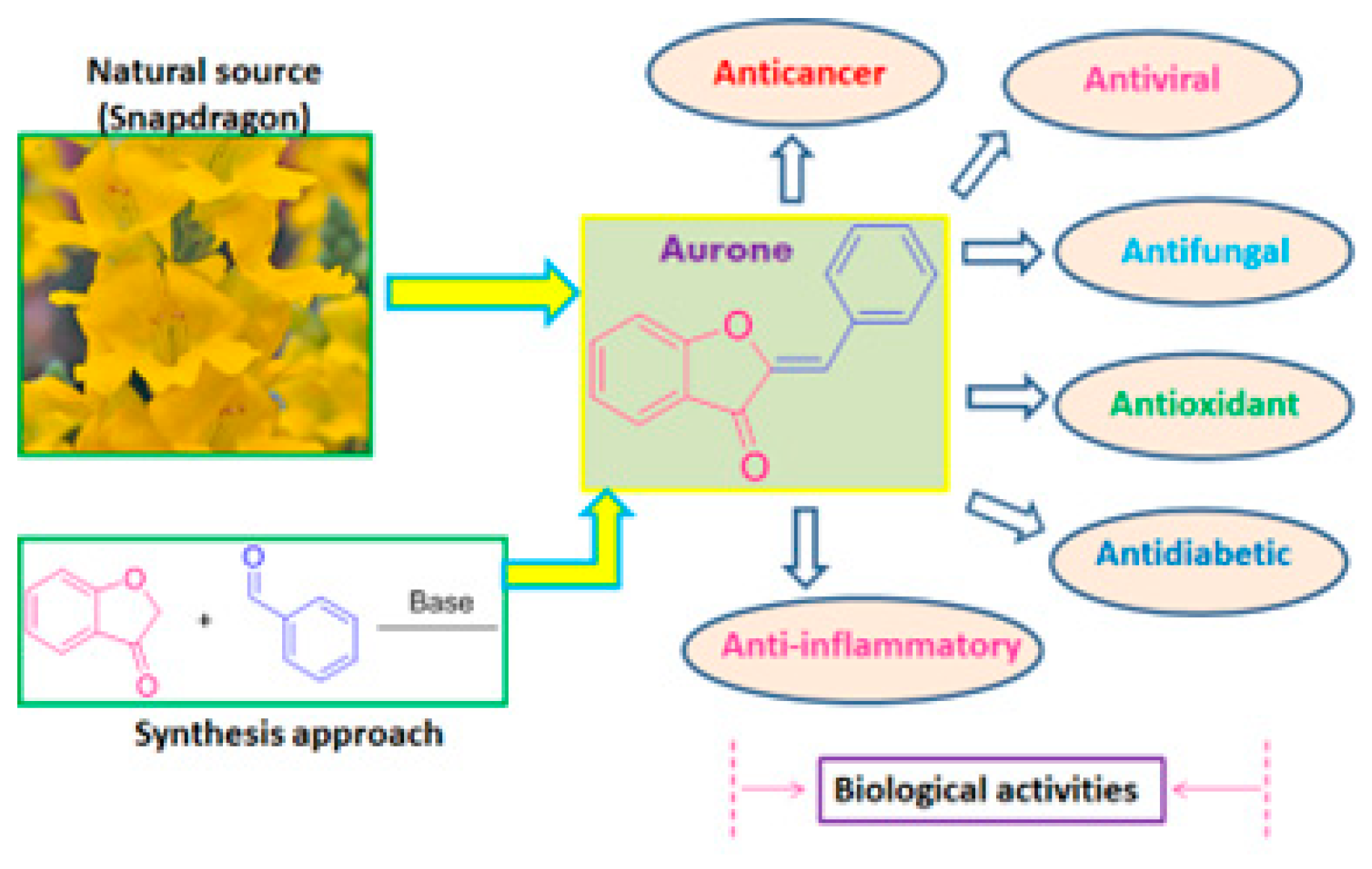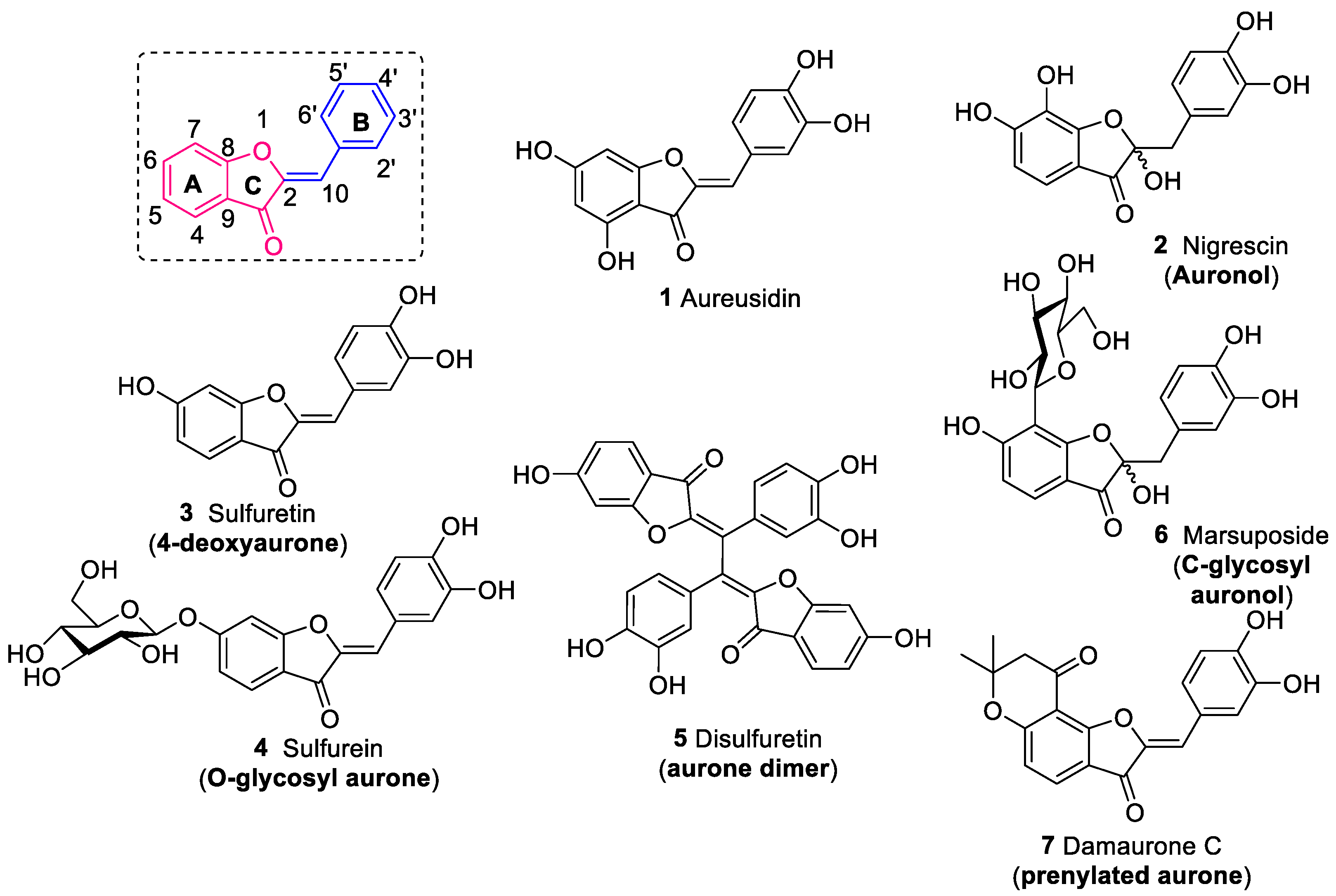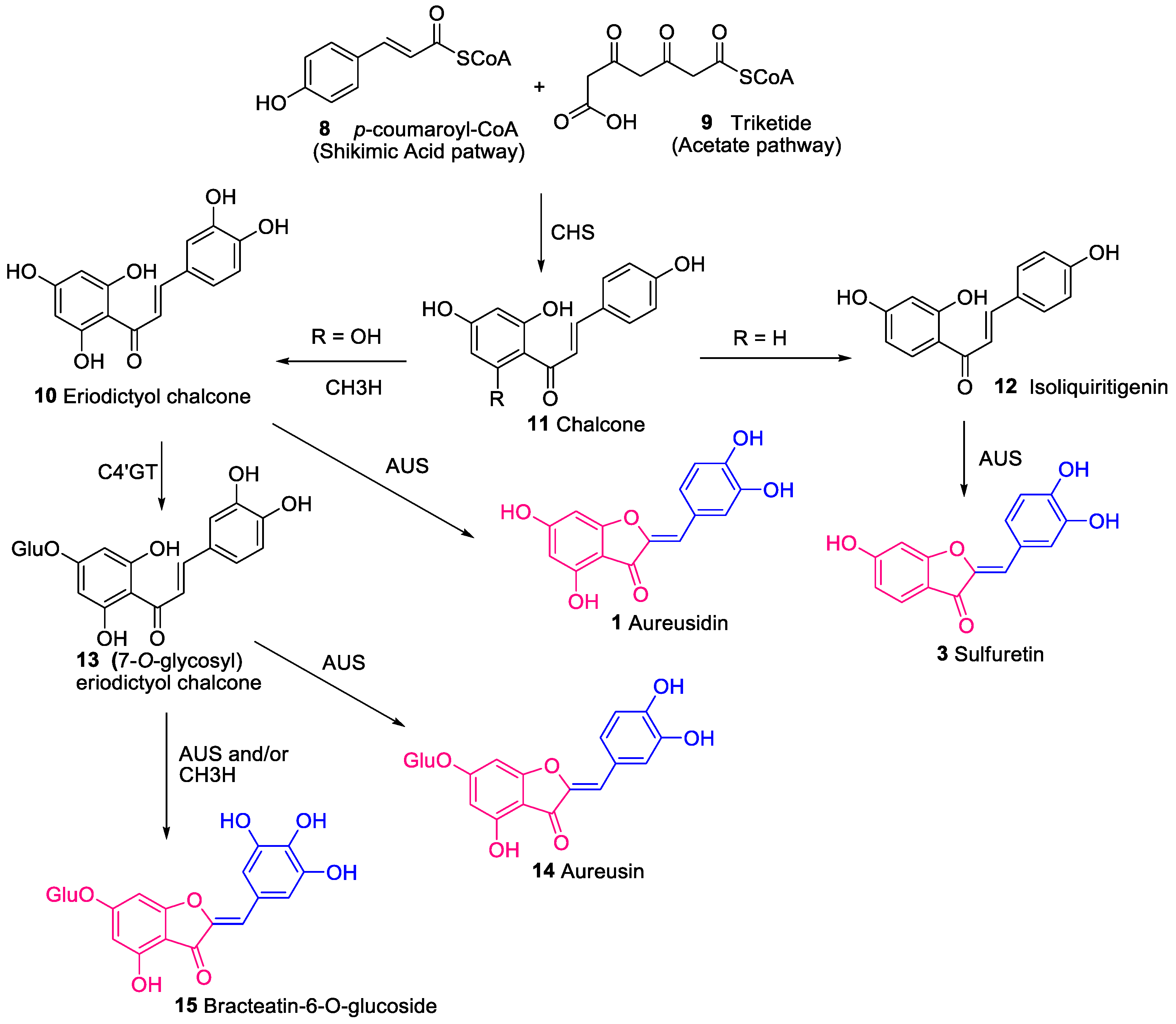Recent Trends in the Antidiabetic Prominence of Natural and Synthetic Analogues of Aurones
Abstract
:1. Introduction
2. Occurrence and Distribution of Aurones
3. Biosynthesis of Aurones
4. Outline on the Concealed Pathways of Aurone Synthesis
4.1. Route 1: Condensation of Benzofuran-3(2H)-one
4.2. Route 2: Annulation of Ortho-Iodophenol
4.3. Route 3: Cyclization of Chalcones
4.4. Route 4: Intramolecular Rearrangement of Oxiranes
4.5. Route 5: Ring Contraction of Flavones
5. Antidiabetic Potentialities of Aurones
| Compound | Antidiabetic Target | IC50 | Ref. |
|---|---|---|---|
| Natural aurones | |||
| Sulfuretin (3) | ALR2 | 1.3 µM | [44] |
| AGE | 124.7 µM | [44] | |
| NF-κB | - | [45] | |
| Millard reaction (non-enzyme) inhibitor | - | [46] | |
| (Z)-6-Hydroxy-2-(4-hydroxybenzylidene)-7-(3-methylbut-2-en-1-yl)benzofuran-3(2H)-one (31) | PTP1B | 11.3 µM | [48] |
| DGAT | 35.2 µM | ||
| α-glucosidase | 73.8 µM | ||
| (R,Z)-2-(3,4-Dihydroxybenzylidene)-7-(2-hydroxypropan-2-yl)-7,8-dihydro-2H-indeno[4,5-b]furan-3(6H)-one (32) | α-glucosidase | 62.1 µM | [48] |
| (2Z)-2-[(4′-Hydroxy-3′-methoxyphenyl) methylene]-6-methoxy-7-prenyl-3(2H)-benzofurane (33) | α-glucosidase | 64.1 µM | [49] |
| Licoagroaurone-6-O-α-L-arabinopyranoside (34) | α-glucosidase | 47.1 µM | [50] |
| Altilisin H (35) | α-glucosidase | 4.9 µM | [51] |
| Altilisin I (36) | α-glucosidase | 5.4 µM | [51] |
| Altilisin J (37) | α-glucosidase | 5.1 µM | [51] |
| Synthetic aurones | |||
| (Z)-2-(3,4-Dihydroxybenzylidene)benzofuran-3(2H)-one (38) | DARK2 | 3.15 µM | [52] |
| (Z)-2-(3-Ethoxy-4-hydroxybenzylidene)-5-methoxybenzofuran-3(2H)-one (39) | DARK2 | 0.33 µM | [52] |
| (Z)-2-(3,4-Dihydroxybenzylidene)-5-methoxybenzofuran-3(2H)-one (40) | DARK2 | 0.25 µM | [52] |
| (Z)-2-Benzylidene-5-(4-fluorophenyl)-6-hydroxybenzofuran-3(2H)-one (41) | α-glucosidase | 30.94 nM | [53] |
| (Z)-6-Hydroxy-2-(2-hydroxybenzylidene)benzofuran-3(2H)-one (42) | mitoNEET | 0.62 nM | [55] |
| (Z)-4,6-dihydroxy-2-(4-hydroxy-3-methoxybenzylidene)benzofuran-3(2H)-one (43) | PPA | 40.25 µM | [56] |
| (Z)-1-(4-((5-methyl-3-oxobenzofuran-2(3H)-ylidene)methyl)phenyl)-3-phenylurea (44) | α-glucosidase | 292.7 µM | [57] |
| (Z)-1-(4-((5-(3-Phenylureido)-3-oxobenzofuran-2(3H)-ylidene)methyl)phenyl)-3-phenylurea (45) | α-amylase | 142.0 µM | [57] |
| α-glucosidase | 6.6 µM | [57] | |
| (Z)-6-(2-benzylidene-4,6-dihydroxy-3-oxo-2,3-dihydrobenzofuran-7-yl)-7-methoxy-2H-chromen-2-one (46) | α-glucosidase | 3.55 µM | [58] |
| α-amylase | 10.97 µM | [58] | |
| Analogue aurones | |||
| (Z)-4-(5-((3-oxobenzo[b]thiophen-2(3H)-ylidene)methyl)furan-2-yl)benzoic acid (47) | PTPM1 | 11.8 µM | [59] |
| (E)-5,6-dimethoxy-2-(2-(2-(thiophen-2-yl)ethoxy) benzylidene)-2,3-dihydro-1H-inden-1-one (48) | PPAR-γ | 0.61 µM | [60] |
| (E)-2-(4-(2-(5-ethylpyridin-2-yl)ethoxy)benzylidene)-5,6-dimethoxy-2,3-dihydro-1H-inden-1-one (49) | PPAR-γ | 1.20 µM | [60] |
Glycosidase Activity of Aurones
6. Conclusions and Future Perspectives
Author Contributions
Funding
Institutional Review Board Statement
Informed Consent Statement
Data Availability Statement
Conflicts of Interest
References
- Punjot, P.; Bishnoi, R.; Kant, R.; Sharma, S.K. Factors associated with peripheral neuropathy among patients with type 2 diabetes mellitus: A cross-sectional study. J. Cardio-Diabetes Metab. Disord. 2021, 1, 25–30. [Google Scholar]
- Schwandt, P. On the occasion of the world diabetes day: Diabetes mellitus–a globally increasing health problem. Int. J. Prev. Med. 2012, 3, 747–748. [Google Scholar] [PubMed]
- Dahlén, A.D.; Dashi, G.; Maslov, I.; Attwood, M.M.; Jonsson, J.; Trukhan, V.; Schiöth, H.B. Trends in antidiabetic drug discovery: FDA approved drugs, new drugs in clinical trials and global sales. Front. Pharmacol. 2022, 12, 807548. [Google Scholar] [CrossRef]
- Rammohan, A.; Bhaskar, B.V.; Venkateswarlu, N.; Gu, W.; Zyryanov, G.V. Design, synthesis, docking and biological evaluation of chalcones as promising antidiabetic agents. Bioorg. Chem. 2020, 95, 103527. [Google Scholar] [CrossRef] [PubMed]
- Galicia-Garcia, U.; Benito-Vicente, A.; Jebari, S.; Larrea-Sebal, A.; Siddiqi, H.; Uribe, K.B.; Ostolaza, H.; Martín, C. Pathophysiology of type 2 diabetes mellitus. Int. J. Mol. Sci. 2020, 21, 6275. [Google Scholar] [CrossRef]
- Zeng, Z.; Huang, S.Y.; Sun, T. Pharmacogenomic studies of current antidiabetic agents and potential new drug targets for precision medicine of diabetes. Diabetes Ther. 2020, 11, 2521–2538. [Google Scholar] [CrossRef]
- Chandrashekhar, M.; Nayak, V.L.; Ramakrishna, S.; Mallavadhani, U.V. Novel triazole hybrids of myrrhanone C, a natural polypodane triterpene: Synthesis, cytotoxic activity and cell based studies. Eur. J. Med. Chem. 2016, 114, 293–307. [Google Scholar] [CrossRef]
- Madasu, C.; Gudem, S.; Sistla, R.; Uppuluri, V.M. Synthesis and anti-inflammatory activity of some novel pyrimidine hybrids of myrrhanone A, a bicyclic triterpene of Commiphora mukul gum resin. Monatsh. Chem. 2017, 148, 2183–2193. [Google Scholar] [CrossRef]
- Rossiter, S.E.; Fletcher, M.H.; Wuest, W.M. Natural products as platforms to overcome antibiotic resistance. Chem. Rev. 2017, 117, 12415–12474. [Google Scholar] [CrossRef]
- Atanasov, A.G.; Zotchev, S.B.; Dirsch, V.M.; Supuran, C.T. Natural products in drug discovery: Advances and opportunities. Nat. Rev. Drug Discov. 2021, 20, 200–216. [Google Scholar] [CrossRef]
- Ayoka, T.O.; Ezema, B.O.; Eze, C.N.; Nnadi, C.O. Antioxidants for the Prevention and Treatment of Non-communicable Diseases. J. Explor. Res. Pharmacol. 2022, 7, 178–188. [Google Scholar] [CrossRef]
- Rammohan, A.; Zyryanov, G.V.; Bhagath, Y.B.; Manjula, K. Antioxidants: Structure-activity of plant polyphenolics. Vitam. Horm. 2023, 121, 395–411. [Google Scholar]
- Grosso, G. Dietary antioxidants and prevention of non-communicable diseases. Antioxidants 2018, 7, 94. [Google Scholar] [CrossRef] [PubMed]
- Bhaskar, B.V.; Rammohan, A.; Babu, T.M.; Zheng, G.Y.; Chen, W.; Rajendra, W.; Zyryanov, G.V.; Gu, W. Molecular insight into isoform specific inhibition of PI3K-α and PKC-η with dietary agents through an ensemble pharmacophore and docking studies. Sci. Rep. 2021, 11, 12150. [Google Scholar] [CrossRef] [PubMed]
- Sui, G.; Li, T.; Zhang, B.; Wang, R.; Hao, H.; Zhou, W. Recent advances on synthesis and biological activities of aurones. Bioorg. Med. Chem. 2021, 29, 115895. [Google Scholar] [CrossRef] [PubMed]
- Alsayari, A.; Muhsinah, A.B.; Hassan, M.Z.; Ahsan, M.J.; Alshehri, J.A.; Begum, N. Aurone: A biologically attractive scaffold as anticancer agent. Eur. J. Med. Chem. 2019, 166, 417–431. [Google Scholar] [CrossRef]
- Mander, L.; Liu, H.W. Comprehensive Natural Products II: Chemistry and Biology; Elsevier: Amsterdam, The Netherlands, 2010; Volume 1. [Google Scholar]
- Harborne, J.B. Comparative biochemistry of flavonoids—I: Distribution of chalcone and aurone pigments in plants. Phytochemistry 1966, 5, 111–115. [Google Scholar] [CrossRef]
- Mazziotti, I.; Petrarolo, G.; La Motta, C. Aurones: A golden resource for active compounds. Molecules 2021, 27, 2. [Google Scholar] [CrossRef]
- Boucherle, B.; Peuchmaur, M.; Boumendjel, A.; Haudecoeur, R. Occurrences, biosynthesis and properties of aurones as high-end evolutionary products. Phytochemistry 2017, 142, 92–111. [Google Scholar] [CrossRef]
- Miosic, S.; Knop, K.; Hölscher, D.; Greiner, J.; Gosch, C.; Thill, J.; Kai, M.; Shrestha, B.K.; Schneider, B.; Crecelius, A.C.; et al. 4-Deoxyaurone formation in Bidens ferulifolia (Jacq.) DC. PLoS ONE 2013, 8, e61766. [Google Scholar] [CrossRef]
- Wang, Y.; Liang, H.; Zhang, Q.; Cheng, W.; Yi, S. Phytochemical and chemotaxonomic study on Ficus tsiangii Merr. ex Corner. Biochem. Syst. Ecol. 2014, 57, 210–215. [Google Scholar] [CrossRef]
- Lazinski, L.M.; Royal, G.; Robin, M.; Maresca, M.; Haudecoeur, R. Bioactive Aurones, Indanones, and Other Hemiindigoid Scaffolds: Medicinal Chemistry and Photopharmacology Perspectives. J. Med. Chem. 2022, 65, 12594–12625. [Google Scholar] [CrossRef] [PubMed]
- Nakayama, T.; Yonekura-Sakakibara, K.; Sato, T.; Kikuchi, S.; Fukui, Y.; Fukuchi-Mizutani, M.; Ueda, T.; Nakao, M.; Tanaka, Y.; Kusumi, T.; et al. Aureusidin synthase: A polyphenol oxidase homolog responsible for flower coloration. Science 2000, 290, 1163–1166. [Google Scholar] [CrossRef] [PubMed]
- Nakayama, T.; Sato, T.; Fukui, Y.; Yonekura-Sakakibara, K.; Hayashi, H.; Tanaka, Y.; Kusumi, T.; Nishino, T. Specificity analysis and mechanism of aurone synthesis catalyzed by aureusidin synthase, a polyphenol oxidase homolog responsible for flower coloration. FEBS Lett. 2001, 499, 107–111. [Google Scholar] [CrossRef]
- Hoshino, A.; Mizuno, T.; Shimizu, K.; Mori, S.; Fukada-Tanaka, S.; Furukawa, K.; Ishiguro, K.; Tanaka, Y.; Iida, S. Generation of yellow flowers of the Japanese morning glory by engineering its flavonoid biosynthetic pathway toward aurones. Plant Cell Physiol. 2019, 60, 1871–1879. [Google Scholar] [CrossRef]
- Markham, K.R.; Andersen, O.M. (Eds.) Flavonoids: Chemistry, Biochemistry, and Applications; CRC Press: Boca Raton, FL, USA, 2006. [Google Scholar]
- Rammohan, A.; Reddy, J.S.; Sravya, G.; Rao, C.N.; Zyryanov, G.V. Chalcone synthesis, properties and medicinal applications: A review. Environ. Chem. Lett. 2020, 18, 433–458. [Google Scholar] [CrossRef]
- Lunven, L.; Bonnet, H.; Yahiaoui, S.; Yi, W.; Da Costa, L.; Peuchmaur, M.; Boumendjel, A.; Chierici, S. Disruption of fibers from the Tau model AcPHF6 by naturally occurring aurones and synthetic analogues. ACS Chem. Neurosci. 2016, 7, 995–1003. [Google Scholar] [CrossRef]
- Schmitt, J.; Handy, S.T. A golden opportunity: Benzofuranone modifications of aurones and their influence on optical properties, toxicity, and potential as dyes. Beilstein J. Org. Chem. 2019, 15, 1781–1785. [Google Scholar] [CrossRef]
- Taylor, K.M.; Taylor, Z.E.; Handy, S.T. Rapid synthesis of aurones under mild conditions using a combination of microwaves and deep eutectic solvents. Tetrahedron Lett. 2017, 58, 240–241. [Google Scholar] [CrossRef]
- Qi, X.; Li, R.; Wu, X.F. Selective palladium-catalyzed carbonylative synthesis of aurones with formic acid as the CO source. RSC Adv. 2016, 6, 62810–62813. [Google Scholar] [CrossRef]
- Xu, S.; Sun, H.; Zhuang, M.; Zheng, S.; Jian, Y.; Zhang, W.; Gao, Z. Divergent synthesis of flavones and aurones via base-controlled regioselective palladium catalyzed carbonylative cyclization. Mol. Catal. 2018, 452, 164–270. [Google Scholar] [CrossRef]
- Agrawal, N.N.; Soni, P.A. A new process for the synthesis of aurones by using mercury (II) acetate in pyridine and cupric bromide in dimethyl sulfoxide. Indian J. Chem. 2006, 45B, 1301–1303. [Google Scholar] [CrossRef]
- Yatabe, T.; Jin, X.; Mizuno, N.; Yamaguchi, K. Unusual olefinic C–H functionalization of simple chalcones toward aurones enabled by the rational design of a function-Integrated heterogeneous catalyst. ACS Catal. 2018, 8, 4969–4978. [Google Scholar] [CrossRef]
- Weng, Y.; Chen, Q.; Su, W. Copper-catalyzed intramolecular tandem reaction of (2-halogenphenyl)(3-phenyloxiran-2-yl) methanones: Synthesis of (Z)-aurones. J. Org. Chem. 2014, 79, 4218–4224. [Google Scholar] [CrossRef] [PubMed]
- Kandioller, W.; Kubanik, M.; Bytzek, A.K.; Jakupec, M.A.; Roller, A.; Keppler, B.K.; Hartinger, C.G. The rearrangement of tosylated flavones to 1′-(alkylamino) aurones with primary amines. Tetrahedron 2015, 71, 8953–8959. [Google Scholar] [CrossRef]
- Parveen, I.; Ahmed, N. A route to highly functionalized stereospecific trans-aminated aurones from 3-bromoflavones with aniline and N-phenylurea via a domino aza-Michael ring opening and cyclization reactions. Synthesis 2019, 51, 960–970. [Google Scholar]
- Zwergel, C.; Gaascht, F.; Valente, S.; Diederich, M.; Bagrel, D.; Kirsch, G. Aurones: Interesting natural and synthetic compounds with emerging biological potential. Nat. Prod. Commun. 2012, 7, 389–394. [Google Scholar] [CrossRef]
- Zheng, Y.Z.; Deng, G.; Zhang, Y.C. Multiple free radical scavenging reactions of aurones. Phytochemistry 2021, 190, 112853. [Google Scholar] [CrossRef]
- Kumar, K.S.; Kumaresan, R. A quantum chemical study on the antioxidant properties of aureusidin and bracteatin. Int. J. Quantum Chem. 2011, 111, 4483–4496. [Google Scholar] [CrossRef]
- Ighodaro, O.M. Molecular pathways associated with oxidative stress in diabetes mellitus. Biomed. Pharmacother. 2018, 108, 656–662. [Google Scholar] [CrossRef]
- Rammohan, A.; Bhaskar, B.V. Frontiers in Clinical Drug Research-Diabetes and Obesity: Chapter 6; Flavonoids as Prominent Anti-Diabetic Agents; Atta-ur-Rahman, Ed.; Bentham Science Publishers Pte. Ltd.: Sharjah, United Arab Emirates, 2021; pp. 31–71. [Google Scholar]
- Lee, E.H.; Song, D.G.; Lee, J.Y.; Pan, C.H.; Um, B.H.; Jung, S.H. Inhibitory effect of the compounds isolated from Rhus verniciflua on aldose reductase and advanced glycation endproducts. Biol. Pharm. Bull. 2008, 31, 1626–1630. [Google Scholar] [CrossRef] [PubMed]
- Song, M.Y.; Jeong, G.S.; Kwon, K.B.; Ka, S.O.; Jang, H.Y.; Park, J.W.; Kim, Y.C.; Park, B.H. Sulfuretin protects against cytokine-induced β-cell damage and prevents streptozotocin-induced diabetes. Exp. Mol. Med. 2010, 42, 628–638. [Google Scholar] [CrossRef] [PubMed]
- Igaki, N.; Sakai, M.; Hata, H.; OImomi, M.; Baba, S.; Kato, H. Effects of 3-deoxyglucosone on the Maillard reaction. Clin. Chem. 1990, 36, 631–634. [Google Scholar] [CrossRef] [PubMed]
- Hidetoshi, T.; Kimura, K.; Yoshihama, M.; Shioda, K.; Negishi, K.; Seri, K. Suppressant for Maillard Reaction. JPH09241165A, 24 January 2007. [Google Scholar]
- Zhu, G.; Luo, Y.; Xu, X.; Zhang, H.; Zhu, M. Anti-diabetic compounds from the seeds of Psoralea corylifolia. Fitoterapia 2019, 139, 104373. [Google Scholar] [CrossRef]
- Chen, H.J.; Zhang, X.S.; Zhang, J.W.; Gu, H.X.; Huang, J.X. Chemical constituents from the stems of Acanthopanax senticosus with their inhibitory activity on α-glucosidase. J. Asian Nat. Prod. Res. 2021, 23, 803–808. [Google Scholar] [CrossRef]
- Liu, M.; Yang, J.S.; Qin, D. Chemical constituents from the aerial parts of Saussurea involucrata with their inhibitory activities on α-glucosidase. J. Asian Nat. Prod. Res. 2022, 24, 685–690. [Google Scholar] [CrossRef]
- Mai, N.T.T.; Hai, N.X.; Phu, D.H.; Trong, P.N.H.; Nhan, N.T. Three new geranyl aurones from the leaves of Artocarpus altilis. Phytochem. Lett. 2012, 5, 647–650. [Google Scholar] [CrossRef]
- Wang, S.; Xu, L.; Lu, Y.T.; Liu, Y.F.; Han, B.; Liu, T.; Tang, J.; Li, J.; Wu, J.; Li, J.Y.; et al. Discovery of benzofuran-3 (2H)-one derivatives as novel DRAK2 inhibitors that protect islet β-cells from apoptosis. Eur. J. Med. Chem. 2017, 130, 195–208. [Google Scholar] [CrossRef]
- Sun, H.; Ding, W.; Song, X.; Wang, D.; Chen, M.; Wang, K.; Zhang, Y.; Yuan, P.; Ma, Y.; Wang, R.; et al. Synthesis of 6-hydroxyaurone analogues and evaluation of their α-glucosidase inhibitory and glucose consumption-promoting activity: Development of highly active 5, 6-disubstituted derivatives. Bioorg. Med. Chem. Lett. 2017, 27, 3226–3230. [Google Scholar] [CrossRef]
- Tam, E.; Sung, H.K.; Sweeney, G. MitoNEET prevents iron overload-induced insulin resistance in H9c2 cells through regulation of mitochondrial iron. J. Cell. Physiol. 2023, 238, 1867–1875. [Google Scholar] [CrossRef]
- Geldenhuys, W.J.; Yonutas, H.M.; Morris, D.L.; Sullivan, P.G.; Darvesh, A.S.; Leeper, T.C. Identification of small molecules that bind to the mitochondrial protein mitoNEET. Bioorg. Med. Chem. Lett. 2016, 26, 5350–5353. [Google Scholar] [CrossRef] [PubMed]
- Roshanzamir, K.; Kashani-Amin, E.; Ebrahim-Habibi, A.; Navidpour, L. Aurones as new porcine pancreatic α-Amylase inhibitors. Lett. Drug Des. Discov. 2019, 16, 333–340. [Google Scholar] [CrossRef]
- Kazempour-Dizaji, M.; Mojtabavi, S.; Sadri, A.; Ghanbarpour, A.; Faramarzi, M.A.; Navidpour, L. Arylureidoaurones: Synthesis, in vitro α-glucosidase, and α-amylase inhibition activity. Bioorg. Chem. 2023, 139, 106709. [Google Scholar] [CrossRef] [PubMed]
- Sun, H.; Song, X.; Tao, Y.; Li, M.; Yang, K.; Zheng, H.; Jin, Z.; Dodd, R.H.; Pan, G.; Yu, P. Synthesis & α-glucosidase inhibitory & glucose consumption-promoting activities of flavonoid–coumarin hybrids. Future Med. Chem. 2018, 10, 1055–1066. [Google Scholar]
- Park, H.; Kim, S.Y.; Kyung, A.; Yoon, T.S.; Ryu, S.E.; Jeong, D.G. Structure-based virtual screening approach to the discovery of novel PTPMT1 phosphatase inhibitors. Bioorg. Med. Chem. Lett. 2012, 22, 1271–1275. [Google Scholar] [CrossRef]
- Chaturvedi, R.N.; Pendem, K.; Patel, V.P.; Sharma, M.; Malhotra, S. Design, synthesis, molecular docking, and in vitro antidiabetic activity of novel PPARγ agonist. Monatsh. Chem. 2018, 149, 2069–2084. [Google Scholar] [CrossRef]
- Barton, D.; Meth-Cohn, O. Comprehensive Natural Products Chemistry; Newnes: Oxford, UK, 1999; ISBN 0-08-091283-4. [Google Scholar]
- Corfield, A.P. (Ed.) Glycoprotein Methods and Protocols: The Mucins; Humana Press: Totowa, NJ, USA, 2007; Volume 125. [Google Scholar]
- Yuan, S.; Liu, M.; Yang, Y.; He, J.M.; Wang, Y.N.; Kong, J.Q. Transcriptome-wide identification of an aurone glycosyltransferase with glycosidase activity from Ornithogalum saundersiae. Genes 2018, 9, 327. [Google Scholar] [CrossRef]














Disclaimer/Publisher’s Note: The statements, opinions and data contained in all publications are solely those of the individual author(s) and contributor(s) and not of MDPI and/or the editor(s). MDPI and/or the editor(s) disclaim responsibility for any injury to people or property resulting from any ideas, methods, instructions or products referred to in the content. |
© 2023 by the authors. Licensee MDPI, Basel, Switzerland. This article is an open access article distributed under the terms and conditions of the Creative Commons Attribution (CC BY) license (https://creativecommons.org/licenses/by/4.0/).
Share and Cite
Aluru, R.; Mukherjee, A.; Zyryanov, G.V.; Majee, A.; Santra, S. Recent Trends in the Antidiabetic Prominence of Natural and Synthetic Analogues of Aurones. Curr. Issues Mol. Biol. 2023, 45, 8461-8475. https://doi.org/10.3390/cimb45100533
Aluru R, Mukherjee A, Zyryanov GV, Majee A, Santra S. Recent Trends in the Antidiabetic Prominence of Natural and Synthetic Analogues of Aurones. Current Issues in Molecular Biology. 2023; 45(10):8461-8475. https://doi.org/10.3390/cimb45100533
Chicago/Turabian StyleAluru, Rammohan, Anindita Mukherjee, Grigory V. Zyryanov, Adinath Majee, and Sougata Santra. 2023. "Recent Trends in the Antidiabetic Prominence of Natural and Synthetic Analogues of Aurones" Current Issues in Molecular Biology 45, no. 10: 8461-8475. https://doi.org/10.3390/cimb45100533





